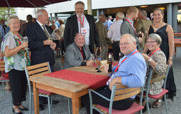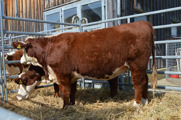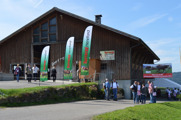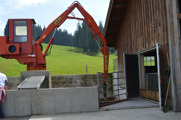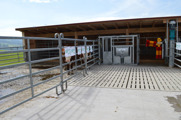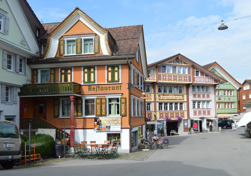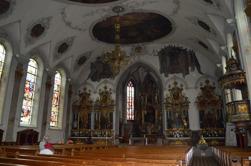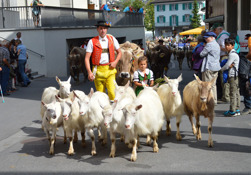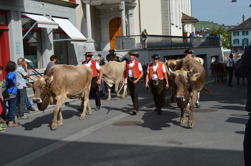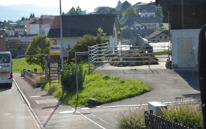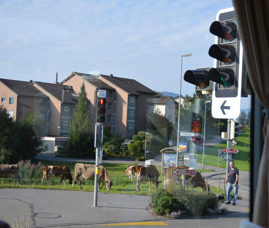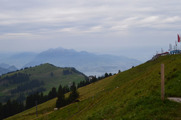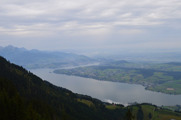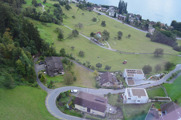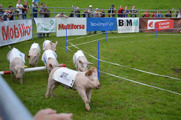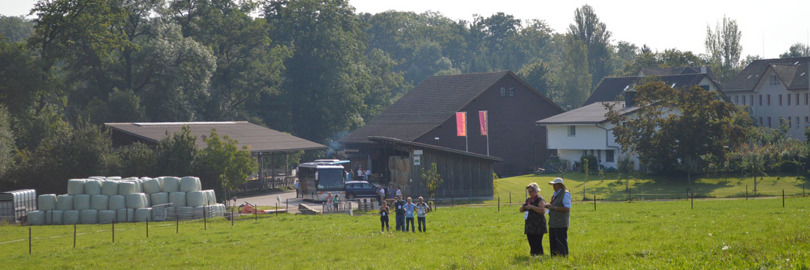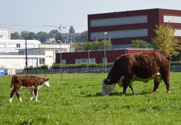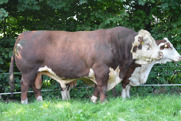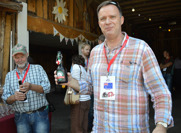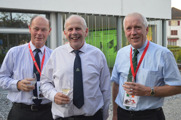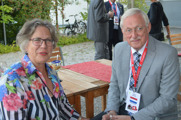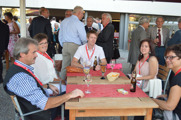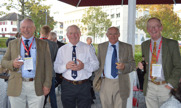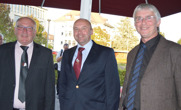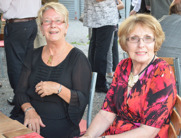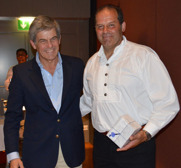
14th European Hereford Conference in Switzerland 2014
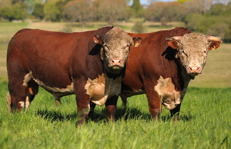
European Hereford Conference 3rd-8th of September 2014
We were approximately 80 people from 13 countries who met at the hotel in Rapperswil, one hour south of Zurich on the evening of Wednesday the 3rd.
Day one, Thursday the 4th of September
The first day we divided up into two coaches headed for Barenegg Hereford in Bächli-Hemberg, two hours on very windy, narrow, steep lanes! Five minutes away from the farm we had to change to a shorter, narrower bus.
We gathered together high up on a mountain, just above the farm next to a field of Herefords, were offered a welcome drink, and a group of traditional folk singers put on a great show for us.
After this, the owner of the farm and president of the Swiss Hereford Association, Walter Fässler, together with the help of a translator, told us about his farm. Barenegg lies 1140 meters above sea level. The average amount of rain is aprox. 1880-2000mm per year. In the winter the temperature is mainly around zero but can go down to as much as minus 10 – 20 for a week or so.
There are approximately. 40 mother cows on the farm, but some cattle from other farms were on display for us. In the winter, the cattle are kept in newly built cold loose housing with deep litter boxes with a scrapeable passage. The cattle were also able to go out doors on an area of slated flooring. The slurry pit was quite interesting, as there was a small excavator on a platform in the middle! Straw that gets into the slurry pit, is lifted up and loaded on to a trailer. Not a bad idea actually!
Calving begins after turn out in the spring, as to avoid the risk of diarrhoea which can start after many calves are born on deep litter.
No cattle on the farm are fed concentrates and the calves that are not used as replacements go to slaughter at ten months. The meat goes as Natura Beef, a national trademark. The farm does two cuts of grass per year. After looking around the farm in brilliant sunshine we were served lunch with beef from the farm. It was very succulent with a wonderful taste.
Click on the photos to enlarge them.
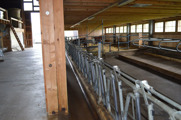
Day one - afternoon
In the afternoon the coaches headed for Appenzell, a small, very picturesque town. The delegates in one bus visited the brewery while the delegates in the other bus went for a look in the main street. Then they swapped so that the other delegates got to visit the brewery to. As I was stood outside a souvenir shop I heard the sound of bells and I saw a little boy and girl, dressed in traditional folk costume, herding some goats! Behind them came a parade of Brown Swiss cows, calves and at the end, a bull, led by a young man. We thought that this must be something for the tourists, but the shop assistant said that this only happens twice a year, when they move the cattle up or down the mountain! We were lucky! There was also a beautifully decorated church, right next to a river that flows through the town. I actually thought that Appenzell reminded me of Llangollen in north Wales.
Photos from Appenzell. Click on the photos to enlarge them
Interesting sights
On our travels we saw some very interesting aspects of farming in Switzerland. Like how they cut grass on steep slopes. They have a mower with very low centre of gravity and with dual wheels. When it was too steep for that, they used a manual, very large lawn mower. Round bales were not to be thought of in some areas and instead they raked the grass down for hand or blew it down with a leaf blower, to the road to be collected. They used small loader wagons which automatically pick up the grass. As you can imagine, these were only small farms.
One thing that really struck me was that in a few villages (and even small towns) that we travelled through, as we were looking at the pretty houses, all of a sudden there were calves in a garden… then I realised that small holdings were blended in among the houses! (That would never work in Sweden) Switzerland really seems to care about small sized farms.
Everywhere we went, was immaculate! Not a blade of grass out of place. We saw mainly Brown Swiss cattle, sheep and goats. Not many horses at all, and I can’t remember seeing a single Simmental – but that could depend on the area I suppose.
Evening meeting.
After dinner, a two hour meeting awaited us, arranged by the WHC General Secretary, José Bonica. On a positive note the Hereford breeds popularity is increasing all over the world and is competing against Aberdeen Angus. The beginning of different Hereford Beef programs and trademarks of pure or crosses, with Herefords, has contributed to the higher demand for Herefords.
On the negative side of things, the problem with breeding values getting often zeroed when they arrive in another country than that of origin. However, this problem has been mainly overcome in the U.K due to using a method which allows an animal in the top 10% in the country of origin to be in the top 25% in the U.K.
I requested that Canada, among other countries, note scurs or polled in their databases and not just as being polled if the animal has scurs. Registering a scured animal as polled can have great economic consequences for some breeders which José commented as being a very real problem for some countries.
José told us that he has visited several countries since he became the General Secretary, but that there are not enough resources to enable him to do more. He would like to see more structure within the WHC and be able to enlist a scientist. John McKew, from Australia said that “you need to know what the goal is, and how much money is needed to reach it before we can begin discussing restructuring. We all need to think what the WHC should be working on.”
I made a point that, to start with, “updating the WHC website would be appreciated, at least with information on upcoming European and World conferences” David Prothero, U.K, expressed his wishes for much better communication prior to the conferences. “Usually the General Secretary will send out information about subjects to be discussed at the conferences about a year before hand, in order to give associations around the world time to discuss them with their boards.”
Day two, Friday the 5th of September.
The next day we travelled to Arth-Goldau and went on the cogwheel train from there to Rigi Kulm, 1797 meters above sea level. Upon reaching the highest point and as far as the railway track went, we stopped for a rest for 15 minutes. Some delegates felt dizzy it was so high up! The view was amazing and there were Brown Swiss cattle grazing on the mountain side. Someone said, what would happen if they lay down wrong? They could end up rolling all the way down! Another fascinating thing was that across the valley we saw fir trees growing – pretty strange really given the altitude.
After eating lunch a bit further down at Rigi Kaltbad, we took the cable car the rest of the way down the mountain to Weggis… something I for one promise never to do again, as the ground swayed under me for two hours after!
From here our next stop by coach was only 10 minutes away and a visit at a small agricultural show. With show I mean that cattle were on display as well as chickens and pigs. The cattle were stationed at several small farms on a hilly walk of about 2km. As the ground was swaying under me, I didn’t go on the walk, but I did get to see the pig race! Hilarious! The pigs did not have docked tails. This among other things that we saw, tells me that Switzerland has a very high ethical treatment of farm animals.
Day four, Sunday the 7th of September
The last day, Sunday the 7th of September, we travelled to Zurich and visited Rinderknechts Beef Ranch. They say that the farm is the last green oasis before the city. The area around Zurich is very flat. We seemed to have driven into an industrial estate and suddenly there was a field with Herefords. One more turn down a road with houses and we were there. The farm was ringed in by a motorway, railway, factories and we saw airplanes taking off! I can’t say that it was the most peaceful part of the world… But the farm was quaint, well planned and the cattle were of very good quality.
The winter housing was a cold loose barn with cubicles filled with straw, open on all sides. One long side was right next to a thick row of trees. Winter time temperature here is usually around zero, so I’m sure the housing worked really well for them. Herefords have been at the farm for ten years and there are aprox. 70 mother cows. The pedigrees were partly familiar to us, and partly not. Most of them originate from Denmark and some from the UK. As with Barrenegg most of the calves are sold to Natura Beef at 10 months of age but some are sold in boxes directly to customers. Replacement heifers graze summertime upon a mountain, 2500 meters above sea level! The farm consists of 70 hectares, half crop and half pasture/grazing land. The grazing where the cows went was very rich and the cows were in very good condition.
Consumers are welcomed to the farm to see for themselves how the cattle are looked after and to learn more about farming. There is a lovely, rustic party barn available for rent on site, and to prove my theory about farms mixing in with areas of housing, there was a slurry pit right outside the door (!)
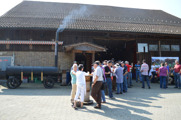
Day four continued
After mingle and lunch in the party barn we went to Europe’s largest waterfall, Rheinfall. Beautiful!
In the evening, it was the gala dinner with live folk music and thanks giving to the Swiss Hereford Association for all their hard work. It was announced that the next European Hereford Conference will take place in Hungary, 2018. Until then we have the World Hereford Conference in Uruguay 2016 to look forward to.

Conclusion
The European Conference is, for me, a far cry from being just a holiday as a tourist (as some may say), even if it is great fun. It’s a huge chance to discuss theories, bloodlines, learn about what other people consider being important in their part of the world etc. Things we do here in Sweden probably won’t always work in other parts of the world and vice versa, but there is always something interesting, that could work, that might just come in handy, one day and be good to know. It’s important not to go around with blinkers on, to keep an open mind.
Until we meet again, best regards, Miranda Lysell.
Secretary of the Swedish Hereford Association and former UK resident.
Below are more photos to enjoy. Click on them to enlarge.
